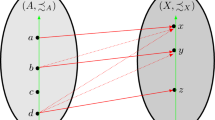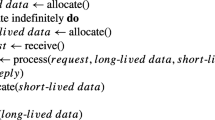Abstract
This paper proposes an algorithm for generating process specifications from communications service specifications described by a graph grammar. In this work, it is assumed that a communications system consists of homogeneous processes and that there is no global database. Processes that share a relationship form a global state, and a communications service defines global state transitions caused by inputs to the processes. A global state is represented by a labeled directed graph and a global state transition is described by a graph replacement rule. A process specification is regarded as a distributed algorithm whose purpose is to achieve the global state transitions described by the graph replacement rules. The communication time complexity of the generated distributed algorithm does not depend on the number of graph replacement rules.
Similar content being viewed by others
References
Awerbuch, B. 1987. Optimal distributed algorithm for minimum weight spanning tree, counting, leader election and related problems.Proceedings of the 19th ACM Symp. on Theory of Computing, 120–140.
Belina, F. and Hogrefe, D. 1989. The CCITT-Specification and Description Language SDL.Comput. Networks ISDN Syst., 16, 311–341.
Bochmann, G.v. 1980. A general transition model for protocols and communications services.IEEE Trans. Comm., COM-28(4), 643–650.
Bolognesi, T. and Brinksma, E. 1987. Introduction to the ISO Specification Language LOTOS.Comput. Networks ISDN Syst., 14, 25–59.
Cameron, E.J., Cohen, D.M., Guithner, T.M., Keese Jr., W.M., Ness, L.A., Norman, C., and Srinidhi, H.N. 1991. The L.0 Language and Environment for Protocol Simulation and Prototyping.IEEE Trans. on Comput., 40(4), 562–571.
Chu, P.M. and Liu, M.T. 1988. Synthesizing Protocol Specifications from service specification in the FSM model. InProc. Comput. Networking Symp., 505–512.
Dendorfer, C. and Weber, R. 1992. From Service Specification to Protocol Entity Implementation—An Exercise in Formal Protocol Development. InProc. IFIP Twelfth Int. Symp. Protocol Specification, Testing, Verification, 163–177.
Drayton, L., Chetwynd, A., and Blair, G. 1992. Introduction to LOTOS through a worked example.Comput. Commun., 15(2), 70–85.
Eijk, P.v., Kremer, H., and Sinderen, M.v. 1990. On the use of specification styles for automated protocol implementation from LOTOS to C. InProc. IFIP Tenth Int. Symp. Protocol Specification, Testing, Verification, 157–168.
Faci, M., Logrippo, L., and Stepien, B. 1991. Formal Specification of Telephone Systems in LOTOS: the Constraint-Oriented Style Approach.Comput. Networks ISDN Syst., 21, 53–67.
Garrahan, J.J., Russo, P.A., Kitami, K., and Kung, R. 1993. Intelligent Network Overview.IEEE Commun. Mag., 30–36.
Gotzhein, R. and Bochmann, G.v. 1990. Deriving Protocol Specifications from Service Specifications Including Parameters.ACM Trans. Comput. Systems, 8(4), 255–283.
Hirakawa, Y. and Takenaka, T. 1991. Telecommunication service description using state transition rules.Proc. Sixth Int. Work. Software Specification and Design, Como, Italy, 140–147.
Kawata, K., Takura, A., and Ohta, T. 1993. On a communication software generation method from communication service specifications described by a declarative language.Proceedings of 5th International Conference on Computing and Information, Sudbury, Canada, 116–122.
Probert, R.L. and Saleh, K. 1991. Synthesis of Communication Protocols: Survey and Assessment.IEEE Trans. Comput., 40(4), 468–476.
Saleh, K. and Probert, R.L. 1991. A Service-Based Method for the Synthesis of communications protocols.Int. J. Mini and Microcomput. Special Issue on Distributed Systems, 12(3), 97–103.
Takura, A., Kawata, K., Ohta, T., and Terashima, N. 1993. Communication Software Generation Based on Two-Layered Specifications and Execution Environment. InIEEE GLOBECOM'93, Houston, USA, 362–368.
Tsai, J.J.P., Weigert, T., and Jang, H.-C. 1992. A Hybrid Knowledge Representation as a Basis of Requirement Specification and Specification Analysis.IEEE Trans. on Software Eng., 18(12), 1076–1100. 1989. Bellcore: LSSGR features common to residence and business customers III, Issue 2. 1992. CCITT, revised Recommendation Z.100, CCITT Specification and Description Language (SDL).
Author information
Authors and Affiliations
Rights and permissions
About this article
Cite this article
Takura, A., Ohta, T. & Kawata, K. Process specification generation from communications service specifications. Autom Software Eng 2, 167–182 (1995). https://doi.org/10.1007/BF00871826
Issue Date:
DOI: https://doi.org/10.1007/BF00871826




